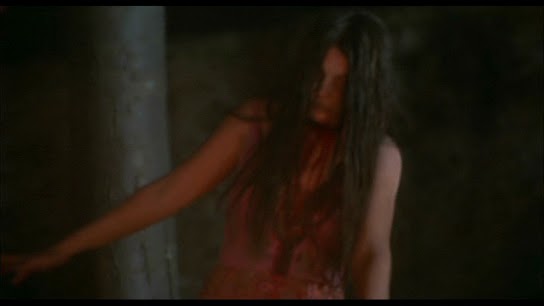Horror Rises opens with a pastoral scene: Alaric de Marnac (Naschy) and his lover, Mabille de Lancré (Liné) are being drawn in a carriage by oxen to a large tree in the middle of a desolate field. De Marnac is decreed a Satanist, a cannibal, a wolfman, etc. and condemned to death. His head will be removed from his body and both will be buried in separate places. Mabille is stripped and hung upside down after also being condemned to death. She curses Andre Roland (Victor Alcázar) and Armand de Marnac (Naschy) before she dies, stating specifically that their descendants will suffer a tremendous punishment. Cut to Paris during the present. Hugo de Marnac (Naschy) visits his artist friend, Maurice Roland (Alcázar), and the two hook up with their girlfriends, Silvia (Betsabé Ruiz) and Paula (Cristina Suriani), respectively. Over cocktails, the four meet with another couple who invite them to a séance. Hugo thinks that séances are phony, so he decided to challenge the medium by invoking the spirit of his ancestor, Alaric de Marnac. The medium successfully channels his spirit, and Alaric reveals the resting place of his head and body. Hugo, still unconvinced, invites Maurice, Silvia, and Paula to his familial estate for a sojourn, whereupon they will attempt to find Alaric’s head and body among the grounds.
Horror Rises from the Tomb escalates in sensationalism with every subsequent scene. My personal favorite scene shows Alaric’s head in a box above a pillar in the crypt where his body is laid. The scene is actually Naschy rigged up so he can deliver orders to his hypnotized slaves. For whatever reason, I find a talking head in a box extremely entertaining. Once Liné’s Mabille is resurrected (in a wonderfully convoluted and sensational manner), she is free to wreak havoc among the population. In a scene which is probably very close to most young men’s dreams of the period, a young man lays in bed reading a photo-magazine of scantily-clad ladies. He looks up from his bed to see Liné standing at his bedside, and with one movement she removes the shear slip that she is donning. The young man embraces her only to have his back ripped to shreds moments later. Emma Cohen plays Elvira, and her father, the caretaker of the de Marnac estate, is one of the film’s first victims. Her younger sister, Chantal (María José Cantudo), is the second to be murdered. In an intimate, sweet scene Hugo visits distraught Elvira who admits that she is all alone in the world. Hugo tells her that she stills has him and that he loves her since they were children. The two kiss, and despite the fact that Elvira has lost two of her closest family members and is very emotionally vulnerable, Naschy as Hugo takes the opportunity to cop a serious feel upon Elvira. Spooky séances, crazed, violent locals, zombies, sorcerers, vampires, buckets of blood, and boatloads of nudity comprise the running time of Horror Rises from the Tomb.
Carmelo A. Bernaola composed an excellent organ score for Horror Rises. The clash of its archaic sound in a contemporary setting is perfect. Naschy’s screenplay, perhaps fueled by desperation, births something amazing, usually only reserved for spontaneity. Carlos Aured was the director of Horror Rises, and he was chosen because he was León Klimovsky’s assistant who was unavailable at the time. (3) The duo of Naschy and Aured would go on to collaborate on El return de Walpurgis (Curse of the Devil) (1972); Los ojos azules de la muneca rota (House of the Psychotic Women) (1973); and La venganza de la momia (The Mummy’s Revenge) (1973). (4) While their subsequent works were all entertaining, none quite have the je ne sais quois of Horror Rises from the Tomb.
1. The quote is from
Naschy, Paul. Memoirs of a Wolfman.
Midnight Marquee Press.
Baltimore, Maryland. 2000: p. 119.
Naschy would repeat the anecdote in the following
interviews:
1. “Paul Naschy
comments on each of his films.” Videooze. Ed. Bob Sargent. No. Six/Seven. Fall 1994.
Alexandria, Virginia. 1994: p. 27.
2. Bouyxou,
Jean-Pierre, Jan Van Genecten, and Gilbert Verschooten. “Interview with Waledmar Daninsky, Alias Paul
Naschy.” Fantoom. Ed. Gilbert Verschooten. No. 5.
Fall/Winter 1977. Grimbergen,
Belgium. 1977, English Supplement: p. 10.
3. Cuenca, José
Ignacio. “The Howl from Overseas.” Fangoria. Ed.
Anthony Timpone. No. 134. Fall 1994.
Starlog Communications International.
New York, New York. 1994: p. 63.
4. Lipinski, Mirek,
Shade Rupe, and The Gore-Met. “The
Creature Incarnate.” Rue Morgue. Ed. Dave Alexander. Issue 98.
Marrs Media Inc. Toronto,
Canada. March 2010: p. 19.
2. Cuenca, José
Ignacio. “The Howl from Overseas.” Fangoria. Ed.
Anthony Timpone. No. 134. Fall 1994.
Starlog Communications International.
New York, New York. 1994: p. 63.
3. Naschy, Paul. Memoirs
of a Wolfman. Midnight Marquee
Press. Baltimore, Maryland. 2000:
p. 119.
4. Ibid. at p. 120.





No comments:
Post a Comment